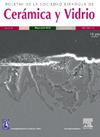使用自制靶材通过射频溅射获得的 BiFeO3 薄膜的物理性质研究
IF 2.7
4区 材料科学
Q1 MATERIALS SCIENCE, CERAMICS
Boletin de la Sociedad Espanola de Ceramica y Vidrio
Pub Date : 2025-03-01
DOI:10.1016/j.bsecv.2024.10.001
引用次数: 0
摘要
近几十年来,铁电材料因其可用于各种电子器件而引起了广泛的关注。BiFeO3 (BFO)具有钙钛矿型ABO3结构,具有反铁磁性和铁电性质,并且在可见光范围内具有带隙,使其成为传感器和太阳能电池中有前途的候选物。本研究采用自制靶材,采用射频溅射法制备了BiFeO3薄膜,并对其进行了不同时间的烧结,考察了烧结时间对其物理性能的影响。利用x射线衍射(XRD)、扫描电镜(SEM)和拉曼光谱对其物理性质进行了评价。这些结果表明,所有薄膜都保持了钙钛矿状结构,具有菱形和富铋的二次相(Bi2O2.33)。原子力显微镜(AFM)和压电响应力显微镜(PFM)图像描述了烧结时间对表面粗糙度和铁电畴重定向的影响。利用反射-透射光谱法测定了样品的光学性质,如n、k和带隙。对生长在玻璃fto衬底上的BFO薄膜在暗光、可见光和紫外光下的光响应进行了评价。本文章由计算机程序翻译,如有差异,请以英文原文为准。

Study of the physical properties of BiFeO3 films obtained by RF sputtering using a homemade target
Ferroelectric materials have attracted significant attention in recent decades because they can be used in various electronic devices. BiFeO3 (BFO) has a perovskite-type ABO3 structure with antiferromagnetic and ferroelectric properties and a band gap within the visible light range, making it a promising candidate for use in sensors and solar cells. In this study, BiFeO3 thin films were grown by radio frequency (RF) sputtering using a homemade target and sintered at different times to evaluate the influence of sintering time on their physical properties. Its physical properties were evaluated using X-ray diffraction (XRD), scanning electron microscopy (SEM), and Raman spectroscopy. These results revealed that all films maintained a perovskite-like structure with rhombohedral and bismuth-rich secondary phases (Bi2O2.33). Atomic force microscopy (AFM) and piezoresponse force micrography (PFM) images depicted the impact of sintering time on surface roughness and ferroelectric domain reorientation. The optical properties, such as n, k, and the band gap of all samples, were obtained using reflection-transmission spectroscopy. The photoresponse under dark, visible and UV illumination were evaluated on BFO films grown over glass-FTO substrate.
求助全文
通过发布文献求助,成功后即可免费获取论文全文。
去求助
来源期刊

Boletin de la Sociedad Espanola de Ceramica y Vidrio
工程技术-材料科学:硅酸盐
CiteScore
5.50
自引率
2.90%
发文量
72
审稿时长
103 days
期刊介绍:
The Journal of the Spanish Ceramic and Glass Society publishes scientific articles and communications describing original research and reviews relating to ceramic materials and glasses. The main interests are on novel generic science and technology establishing the relationships between synthesis, processing microstructure and properties of materials. Papers may deal with ceramics and glasses included in any of the conventional categories: structural, functional, traditional, composites and cultural heritage. The main objective of the Journal of the Spanish Ceramic and Glass Society is to sustain a high standard research quality by means of appropriate reviewing procedures.
 求助内容:
求助内容: 应助结果提醒方式:
应助结果提醒方式:


